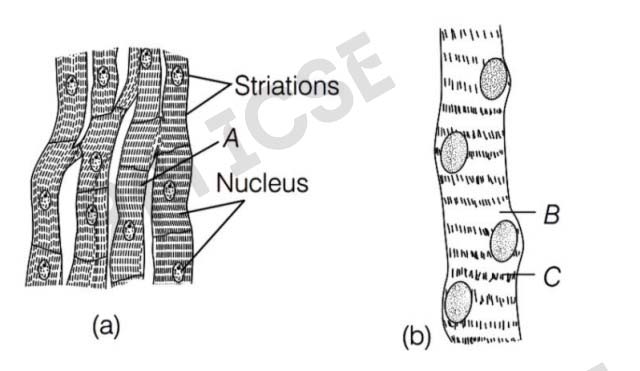Q1 How does simple permanent tissue differ from complex permanent
tissue?
Solution :
Simple permanent tissue is made up of only one type of cells, whereas
complex permanent tissue is made up of more than one type of cells.
e.g. simple tissue-parenchyma,
complex tissue-xylem

Q2 How does the cork act as a protective tissue?
Solution :
• Cork is several layers thick and known as the bark of tree. The cells of
cork are dead and compactly arranged without intercellular spaces.
• They have a chemical called ‘suberin’ in their walls. The suberin makes
cork cell impervious to gases and water.
• Thus, it protects underlying tissues from desiccation(to preserve drying).
Q3 Describe the structure of striped muscle
Solution :
• The striped muscle cell is surrounded by a membrane called sarcolemma.
The myofibrils present in the sarcoplasm shows alternate light and dark
bands.
• Dark bands are called A-bands and light bands are called I-bands. Every
light band has a dark zone.
• The region between two dark lines is called as sarcomere and it is the
functional and structural unit of muscle.
Q4 State the two types of processes present in neuron
Solution :
Two types of processes present in neuron are:-
(i) Axon - It carries impulses away from the cell body
(ii) Dendrite - It carries impulses towards the cell body
Q5 How does the tissue system in multicellular organisms promote division
of labour?
Solution :
• There is a division of labour in multicellular organisms. Different functions
like digestion, respiration, excretion, etc., is taken up by different groups
of cells or tissues.
•
Tissues in these organisms carry out one particular function and are
specialised to perform the same hence, do it efficiently, e.g. xylem is
specialised to conduct water and minerals
Q6 Give the name of the kind of tissue found at:
(i) Tip of plant roots
(ii) Lower surface of leaf
(iii) Lateral sides of stems
(iv) Tissue concerned with the conduction of food materials
(v) Tissue capable of cell division
(vi) Multiple pore present in epidermis of leaf
Solution :
(i) Apical meristem
(ii) Intercalary meristem
(iii) Lateral meristem
(iv) Complex tissue (phloem)
(v) Meristematic tissue
(vi) Stomata
Q7 Differentiate between parenchyma, collenchyma and sclerenchyma.
Solution :

Q8 Differentiate between blood and lymph.
Solution :

Q9 Describe the following and mention where can you find them in your
body.
(i) Chondrocytes
(ii) Axons
(iii) Ciliated epithelium
(iv) Cuboidal epithelium
Solution :
(i) Chondrocytes are cartilage cells. These are present in the tip of nose, pinna
of ear, joints between the adjacent vertebrae in the vertebral column, etc.
(ii) Axons is the longest outgrowth of a neuron. It conducts the impulse away
from the cell body.
(iii) Ciliated epithelium the columnar epithelial cells when bear cilia are called
ciliated epithelia. The ciliated epithelium is found in the respiratory tract.
(iv) Cuboidal epithelium have cube like cells. They are found in kidney tubules,
salivary glands, etc.
Q10 Answer the following questions:

(i) Identify diagrams (a) and (b).
(ii) Label A, B and C.
(iii) Which one of them acts as impulse booster?
(iv) Which one of them is under control of our will?
Solution :
(i) Figure (a) is cardiac muscle fibres. Figure (b) is skeletal or striated muscle
fibres.
(ii) A-Intercalated disc; B-Light band; C-Dark band
(iii) Intercalated disc acts as an impulse booster.
(iv) Skeletal or striated muscle is under control of our will.






